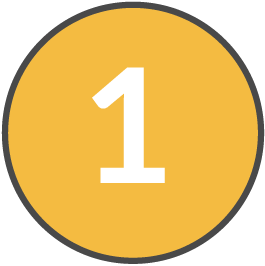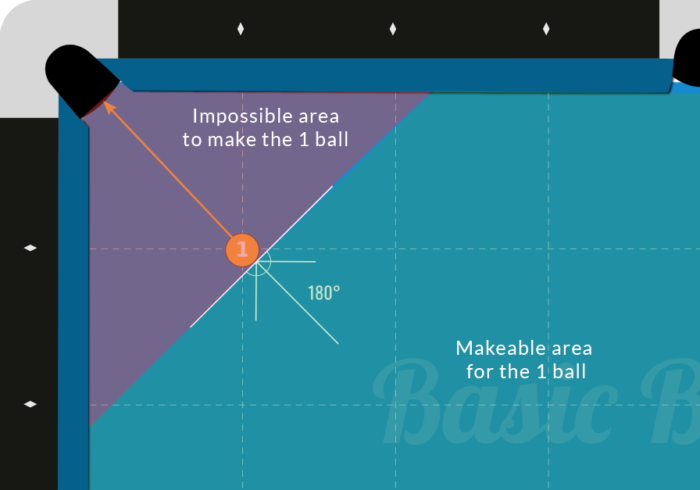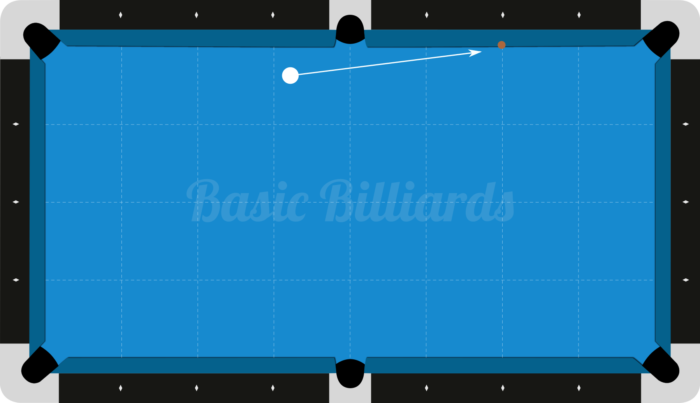Welcome to Basic Billiards where we will teach you the basics of how to play pool so you can have fun and win tournaments!
Aiming is one of the most important aspects to playing pool, because without the ability to aim accurately and consistently it will be difficult to play the game. So in order to aim effectively you need to figure out how to sight the ball you are trying to pocket (which is called the object ball). Sighting the ball means that you need to find the correct contact point on the object ball that you want to hit with the cue ball. If this contact point is struck with the cue ball then the object ball will find the pocket that it was targeting.
Ghost Ball Aiming System
Finding the correct contact point is the key to playing well in pool and there are many different systems that you can use to achive this result. One of the most common methods of to find the contact point on the object ball is called the ghost ball method. When lining up the shot imagine the cue ball being right in line with the pocket you are trying to shoot the object ball as illustrated below.








If you hit that exact spot with the cue ball then the object ball will be pocketed. Some things to keep in mind is that when aiming the cue ball at the contact point on the object ball is that using the center of the cue ball as an aiming point will only work with straight in shots. Generally when performing a cut shot you will be striking the object ball with an edge of the cue ball. This may sound complicated, but if you spend some time on the practice table you will get the hang of it fairly quickly and you won’t even need to use the ghost ball system to be effective.
Range of Angles You Can Make
There are limits to what shots can be made playing pool. However, it’s a pretty wide range depending on how straight your stroke is and how good you eyesight is. But basically any cut shot that’s less than a 90 degree angle can be made. That means there’s a 180 degree area in front of the object ball where it can be made to any pocket. This is one reason it’s a great idea to learn how to cut object balls thin because if gives you more offensive options at the table.

Practicing Getting a Feel for Not Aiming the Center of the Cue Ball
Beginners often have a tendency to try to aim the center of the cue ball when trying to hit a target. But because the cue ball is a sphere, you’re rarely hitting anything with the direct center of the cue ball. Most of the time when the cue ball makes contact with another ball it won’t hit the center of the cue ball, but a part of the side of the cue ball. The only time this isn’t the case is on perfectly straight in shots.
A good drill to get the hang of this phenomenon is to place a coin hanging just a hair off the side cushion of the pool table. Then place the cue ball about a balls width away from the cushion and try to hit the coin so it moves. If you’re aiming the center of the cue ball to hit the coin, then you’re going to miss. Only by aiming a piece of the cue ball that will hit the coin at that particular angle will you be able to move the coin.

Sighting the Contact Point
Now that you have an idea of how to find the contact point, there are a few practical steps you can use to make sure you know how to aim down on the shot. The idea when finding the contact point is to get behind the shot, find the contact point, and then remember or keep your eye on that point all the way up until you have to take the shot.
Here are 6 steps to help with that process:
- Stand behind line of shot to find aiming point.
- Walk behind cue ball keeping your eye on contact point you want to hit and get ready to shoot.
- Keep your eyes on the contact point you want to hit all the way as you get down on shot.
- Once down on shot, you can check check which spot you want to hit the cue ball.
- From here you want to check the cue ball then aim at the contact point of the object ball back and forth as you stroke.
- On the backstroke just before you shoot, look at the point you want to hit on the object ball and keep looking at it until you finish your stroke.
When you feel comfortable with your practice strokes go ahead and take your shot. This process may take some getting used to starting out, but after a little practice this system will become more and more natural for you.
Habits to Avoid While Aiming
There are a few common errors that you should try to avoid while aiming. Here are a few of the most common errors beginners make when trying to aim in pool.
- Don’t change your aim when your taking your practice strokes. This is the most common error I see when people first learn to play pool. Is they find their aiming line, set up correctly, and then they decide to move and change their aim while they’re taking their practice strokes. All of your aiming should take place before getting down on the shot. If anyone is ever not sure about their aim, they should get up, reinspect the contact point they want to aim at, and get back down to shoot again.
- Don’t jerk your head while shooting to check your aim or see if the ball went in. Head movement is a big no no in pool. The ideal shot should have every part of your body very still except for your elbow and forearm which move the cue to hit the cue ball. So if you’re trying to move while you’re going to hit the ball to see if you hit it well or will it to hit the object ball correctly you may be messing up your aim. You want to fully follow through on a shot so you know that your cue was delivered correctly.
- Walk into the shot when getting down to shoot. A good idea when getting down on the shot after picking your aiming point is to walk into the shot as you get down to shoot. Some beginner players will move their cue from the side to get down on the shot, or they’ll step backwards as they get down to shoot. These methods have issues because you can’t visually keep your eye and cue in line while your moving to aim the shot. When you step forwards, however, your eye is always on the contact point it needs to be and you’re moving your cue in a vertical direction to get down on the shot with minimal side movement.
With these few tips, you should be able to sight the aiming point on the cue ball and increase the number of balls you make each time you get to the table.
